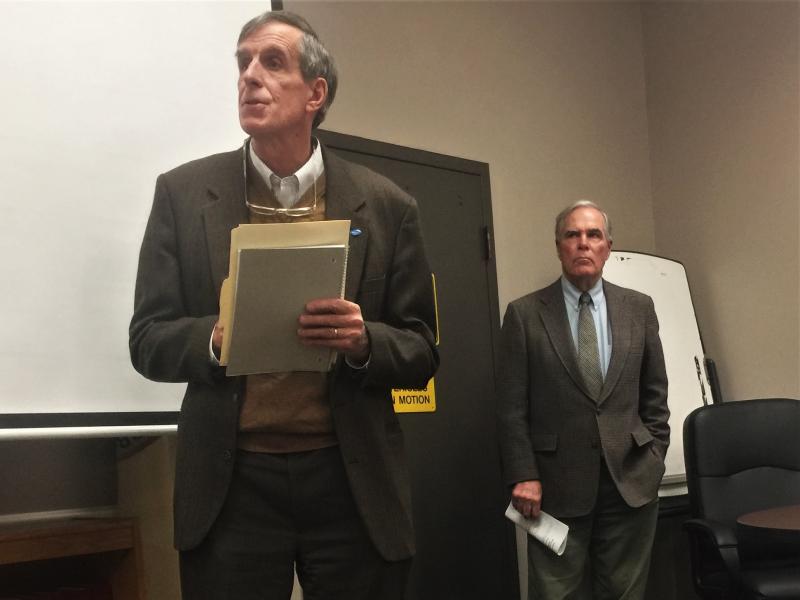Maine Preservation calls Boothbay Harbor demos 'wake-up call'
Many think historic preservation is all about museums or battlefields, teacups and cannons. Maine Preservation is mostly about real estate, said Executive Director Greg Paxton. Paxton and Maine Preservation’s Field Service Advisor Chris Closs were invited to speak about Boothbay Harbor’s place on the nonprofit's list of most endangered harbors in Maine, at the Nov. 26 selectmen's meeting.
Maine Preservation is a statewide historical preservation organization, independent from the state, said Paxton. Closs said one of the key components of preservation is identifying important cultural resources, usually through an architectural survey.
“The last time Boothbay Harbor did that was in 1981. Most communities tend to update these every 20 years or so. In order to keep your comprehensive plan current, that would be one suggestion.”
Another area is preserving the economic opportunity historic buildings represent. "The National Register (of Historic Places) is important because it offers limited protection from other federally financed or permitted programs,” said Closs. “That can also be a critical factor when you have sewer upgrades, highway widenings, even branch banks – anything with a federal stamp on it comes under the aegis of the National Register of Historic Places if a building is either eligible or listed.”
Closs also listed “demolition delay” as a tool to protect historic buildings, typically with a temporary ordinance, but can be done as a permanent ordinance. Closs said this gives the private market an incentive to find another solution.
In the last two years, 16 buildings have been demolished in Boothbay Harbor, said Closs. "That, to us, is a wake-up call.”
Closs and Paxton recommended the town update the section of its comprehensive plan that addresses cultural resources, and conduct a new town-wide survey, preferably with volunteers.
“The value of using volunteers is that between 20 and 30 people get to learn a lot more about their community and become more invested in it,” said Closs. “We like to attract the younger folks to help with that.”
Finally, Paxton and Closs recommended developing a local historic district ordinance once the survey is complete and the town gets a better sense of the boundaries between historic neighborhoods.
The working waterfront is an important heritage issue in Maine, said Paxton. With a history of about 400 years of fishing and working waterfront, only 20 miles of the 5,300-mile mainland and island coast are dedicated to working waterfront – and only eight of those miles are dedicated to public access.
“The Maine state Planning Office suggested that by 2050, almost all of Maine's coast is going to be able to be classified as either suburban or urban,” said Paxton.
However, Paxton also said Boothbay Harbor is moving in a good direction with the Boothbay Region Maritime Foundation’s purchase of the Sea Pier and the town’s efforts toward rezoning on the east side.
Said Paxton, “We think you should continue with the development of your planning … (but) have in mind what you want things to look like as you move toward the rezoning.”
Sidewalks, east side, and an application
Selectmen Mike Tomko and Denise Griffin and Town Manager Tom Woodin met with representatives of the Maine Department of Transportation about bike and sidewalk plans sidelined for the past couple years.
“It's time to dust it off again particularly in light of the terrible bicycle tragedy, fatality that we had on Route 27,” said Griffin. “We don't need any more of those in this community.”
Griffin said the town learned from MDOT, Boothbay Harbor can probably talk about installing sidewalks on most roads, but the boards need to get a better handle on where the state's rights of way are.
“We need to do what we can,” said Griffin. “We may not be able to put sidewalks in all over town, but we're never going to know unless we can figure out where the state right of ways are.”
Woodin inquired about a survey of the area from the Fish Pier to the Footbridge and found it will cost about $2,800. The board was eager to do more, but Woodin noted the price will change if the boundaries change. Cautious to take sidewalk and bicycle lanes in small chunks, the board voted unanimously to have Woodin move forward with the survey as the board mulls which areas of town might be next.
Chair Wendy Wolf said the town is seeking a professional, independent planner to review the work of the planning board once it finishes its proposals.
Wolf said she, Tomko, Woodin, Code Enforcement Officer Geoff Smith and two members of the planning board met to form questions for the consultant to focus on, and have already spoken with some potential consultants.
Said Wolf, “We're trying to get that focus sharpened up so it's very clear what we're asking to be done and that it can be done in a really timely way.”
After contentious debate as to whether or not the subject of the east side zoning proposals was relevant to the board of selectmen, Ken Fitch, spokesman for the Friends of the Harbor, was granted the opportunity to present his group's idea of a reasonable counterproposal.
“We're suggesting that you highlight the area from Oceanside to the footbridge as a limited commercial district, just a change in percentage of where you are putting the limited commercial zone," Fitch said.
Allison Prawler, represented by environmental consultant Tim Forester of Atlantic Environmental, sought to replace a 10'x20' seasonal float with a 12'x36' seasonal one with an attached 4'x40' finger float at 3 Ships Point Road. The board unanimously approved.
Financial Officer Julia Latter said the town’s revenue and expenses, year to date, total $4,405,696 and $4,096,921, respectively. The total accounts payable are $32,333.48 and the bank balance is $2,695,288.96.





























